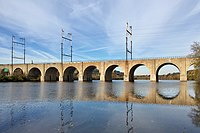Raritan people
 General area of Raritan territory | |
| Total population | |
|---|---|
| No longer distinct tribes. | |
| Regions with significant populations | |
| New Jersey[1] | |
| Languages | |
| Munsee language | |
| Religion | |
| Indigenous religion | |
| Related ethnic groups | |
| other Lenape tribes |
The Raritan are two groups of Lenape people who lived around the lower Raritan River[1] and the Raritan Bay, in what is now northeastern New Jersey, in the 16th century.
Name
[edit]The name Raritan likely came from one of the Lenape languages (among the languages in the Algonquian language group), though there are a variety of interpretations as to its meaning. It may derive from Naraticong [2] meaning "river beyond the island."
Raritan is a Dutch pronunciation of wawitan or rarachons, meaning "forked river" or "stream overflows".[3]
The first group known as the Raritan was also known as the Sanhicans.[4] A second group, known as the Wiechquaeskecks,[1] Wisquaskecks, Roaton, Raritanghe,[5] and Raritanoos settled the Raritan watershed area after the first departed.[4][1]
History
[edit]
The original Raritans, the Sanhicans, lived along Raritan Bay's west shore[4] until 1640s, when attacks from the Delaware River Indians and Dutch settlers drove them inland.[1]
The Wisquaskecks had lived in what is now Westchester County, New York.[6] After the Sanhicans migrated east, the Wisquaskecks[4] moved into the area by 1649 and then also became known as the Raritans.[1]
The Raritan had early contact with settlers in the colony of New Netherland.[7][8] Dutch colonist David Pietersz. de Vries described the Raritans as "a nation of savages who live where a little stream [the Raritan River] runs up about five leagues behind Staten Island."[5] He wrote that Cornelis van Tienhoven took more than one hundred men to the Wisquaskecks to address their theft of pigs and attempt theft of a yacht. Van Theihoven's group killed several of the Wisquaskecks and took their chief's brother as a hostage.[5] Van Theihoven tortured the prisoner, and the Americans Indians responded to the attack by killing several Dutch settlers.[5] William Kieft, governor of New Netherland, had planned the extermination campaign against them. The attack against the American Indians was a contributing event to the bands' allying in Kieft's War (1643-45) against the settlements of New Netherland.[7]
In 1649, the Wisquaskecks held a peace conference with the Dutch settlers. Pennekeck, a leader from Newark Bay, "said the tribe called Raritanoos, formerly living at Wisquaskeck had no chief, therefore he spoke for them, who would also like to be our friends...."[4] The Sanhicans unsuccessfully tried to contest Pennekeck.[4][9]
See also
[edit]Notes
[edit]- ^ a b c d e f Ives Goddard, "Delaware," p. 213.
- ^ "The Origin of New Jersey Place Names" (PDF). New Jersey State Library Commission. Federal Writers' Program. 1938. Archived from the original (PDF) on December 5, 2004. Retrieved January 6, 2009.
- ^ Virginia B. Troeger and Robert James McEwen, New Jersey's Oldest Township, Charleston, SC: Acadia Publishing, 2002, p. 18
- ^ a b c d e f Wright, Kevin W. "Native Americans in Bergen County". Bergen County Historical Society. Retrieved February 24, 2023.
- ^ a b c d David de Vries's Notes, Narratives of New Netherland, p. 208.
- ^ Ives Goddard, "Delaware," p. 237.
- ^ a b Shorto, Russell (2004). The Island at the Center of the World: The Epic Story of Dutch Manhattan and the Forgotten Colony that Shaped America. Random House. ISBN 1-4000-7867-9.
- ^ "A Tale of Tienhoven". Archived from the original on February 17, 2020. Retrieved September 3, 2009.
- ^ "Trenton Historical Society, New Jersey". trentonhistory.org.
References
[edit]- Ives Goddard (1978). "Delaware". In Trigger, Bruce G. (ed.). Handbook of North American Indians: Northeast, Vol. 15. Washington, DC: Smithsonian Institution. pp. 213–39.
- David de Vries (2009). Jameson, John (ed.). Narratives of New Netherland: 1609–1664. Carlisle, MA: Applewood Books. p. 218. ISBN 9781429018968.

